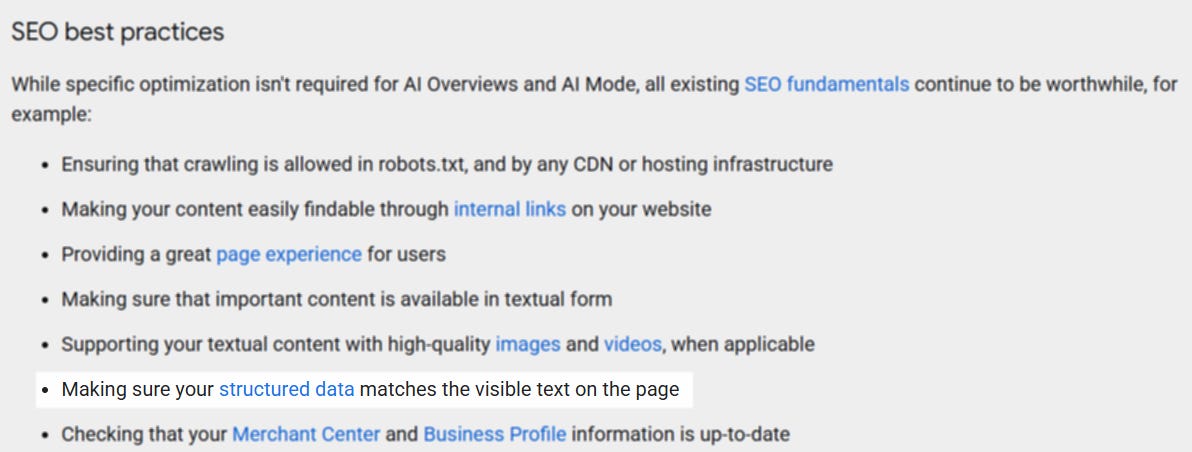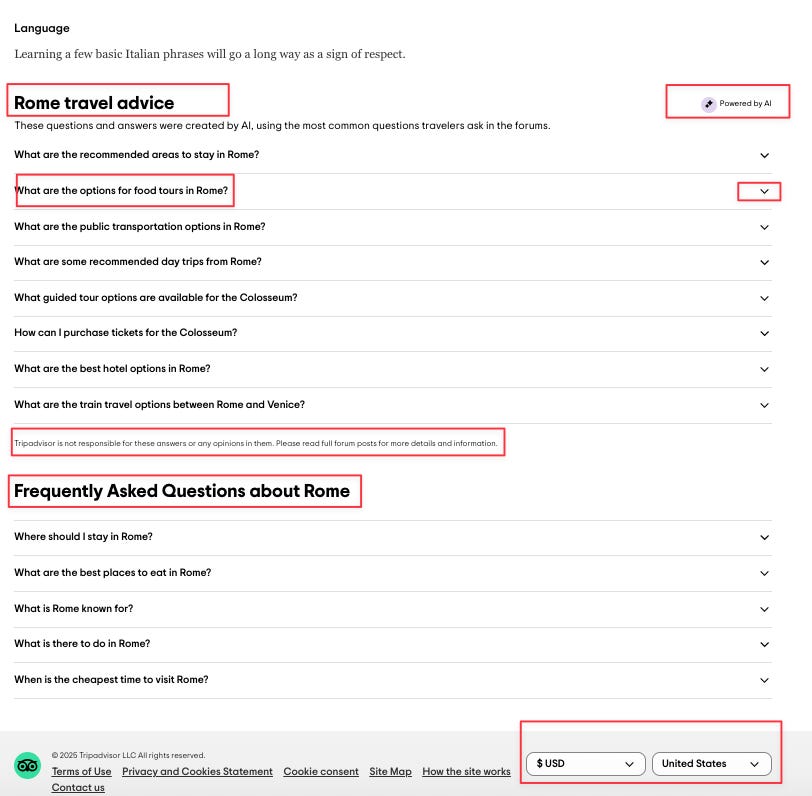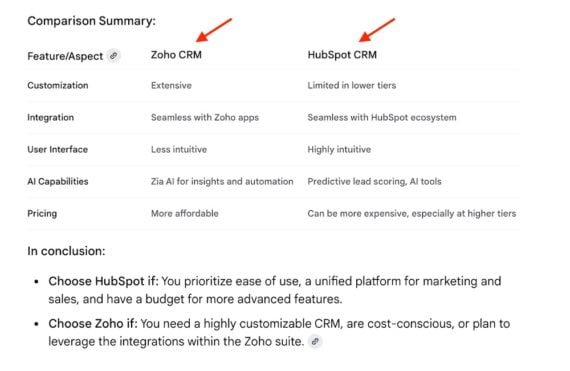Effective Marketplace SEO Is More Like Product Growth via @sejournal, @Kevin_Indig
Below, I’ve got an update on my marketplace SEO issue – and this edition is more robust, taking into account learnings from the UX study of AIOs as well as the latest shifts in the search landscape.
(Shifts that, I’d argue, have a disproportionate impact on online marketplaces.)
I’ll cover:
- What marketplace SEO is and why it’s different.
- The top 3 things marketplace SEO practitioners need to keep in mind about AI + LLMs.
- How to do marketplace SEO from a product growth approach.
- An incredible real-world example from Tripadvisor (they’re killing it over there).
Plus, premium subscribers will get my five-phase framework to ensure you’re approaching marketplace SEO from an overall product growth perspective … and my top considerations for marketplaces to stay ahead of competitors and LLMs. (That’s all at the end of this issue. You can subscribe to get full access here.)
Also, a quick thanks to Amanda Johnson, who partnered with me to bring this marketplace SEO issue into 2025.
Boost your skills with Growth Memo’s weekly expert insights. Subscribe for free!
In my opinion, there are two major types of SEO: product-led and marketing-led.
Marketplace SEO (as I call it) is a product-led SEO function of your organization. Without it, companies like Tripadvisor, Zillow, Meta, or Glassdoor wouldn’t be where they are today.
The key lessons about marketplaces from my time at G2 and my work with Nextdoor, Bounce, and others: Good SEO is the result of product growth, not just website optimization.
It’s a different way to think about and execute SEO because marketplaces have massive scale advantages over other types of businesses.
But AI threatens this moat.
And this is mission critical: 80% of new users coming from SEO is not uncommon for marketplaces. Yes, even in the current SEO landscape.
In fact, I called this out in March 2025 in CheggMate – that information sites, especially marketplaces, are being disproportionately affected in search by AIOs and LLMs.
Why understanding marketplace SEO matters: Most sites on the web are not marketplaces. The approach to marketplace SEO is very different from non-marketplace sites. Applying the wrong approach severely limits the impact on company growth.
If you’re running a marketplace site (which I also sometimes call an SEO aggregator), your goal is to become a trusted source that retrieval layers (RAG), AI Overviews, and chatbots pull from directly.
This requires opening your site to AI crawlers, baking in rich schema, exposing structured APIs or data feeds for RAG pipelines, and continually fueling fresh, authoritative UGC.
Meanwhile, AI tools are churning out optimized titles, descriptions, and rich snippets across millions of pages faster than any human team could.
Essentially, marketplace SEO has evolved into a true product-growth partnership, where UX, community incentives, and AI visibility all work together to keep up visibility with our audiences.
Let’s talk about how to do that.
But first, we have to get on the same page about what marketplace SEO entails (because you know how our industry likes to throw around new buzzphrases every day).
What Is Marketplace SEO?
Marketplace SEO is the practice of optimizing a site based on its inventory (supply) so that potential buyers (demand) land directly on your marketplace when they’re about to make a decision, like a software purchase, booking a flight, scheduling a medical appointment, etc.
Marketplaces often rely on user-generated reviews and commentary (plus the right technical signals) to build trust and relevance.
Think of marketplace SEO as the art – and science – of making two-sided platforms (like G2, Tripadvisor, ZocDoc, or Nextdoor) impossible to miss.
Their unique advantage comes from having a large number of pages on their site across a few different templates, which leads to multiplier effects for internal linking, testing, and target audience size.
Marketplaces orchestrate thousands (even millions) of user-generated listings, reviews, and seller storefronts so that search engines point back to the service you provide: connecting consumers to solutions they need.
In short, marketplace SEO is about optimizing the entire ecosystem – beyond the homepage or blog – to turbocharge discoverability for every seller, every listing, every time.
Is Marketplace SEO Product-Led SEO?
They definitely share DNA, but marketplace SEO stands on its own.
Like product-led SEO, we embed optimization into the product experience itself, using user actions (reviews, ratings, uploads) as our content engine.
But on a marketplace site, we also juggle multi-vendor dynamics, inventory churn, and network effects that a standalone SaaS app doesn’t face.
At G2, for example, we saw real SEO gains from optimizing the review submission process (by encouraging longer reviews to create more content), which wouldn’t necessarily fall into product-led SEO.
So yes, it’s product-led in spirit because we grow through the product and improvements to the marketplace, but it demands marketplace-specific plays to keep the flywheel spinning.
With marketplace SEO, you’re playing in the same sandbox as product-led SEO, but perhaps with a few extra toys.
Marketplace SEO Is Inherently Different Than Other SEO Programs – And It Deserves A Deeper Understanding Of The Impact Of AI
If the overwhelming majority of new users heading to marketplaces are coming from organic search, understanding the differences between regular old SEO and marketplace SEO is absolutely crucial.
- Marketplaces have a low per-user revenue: Low ARPU, or Average Revenue Per User, often makes advertising or outbound sales too expensive for buyer/seller marketplaces.
- Scaling visibility looks different for marketplaces by industry: Retail marketplaces can scale on advertising but lean on SEO to diversify growth channels and make marketing spend sustainable.
- The majority of marketplaces are UGC-based: In the era of AI-generated consensus content, UGC-based marketplaces have an edge, especially ones with high trust signals that cull out fake user content and reviews.
In addition to these core differences, marketplaces are aggregators. (You can read more about my thoughts on SEO integrators vs. aggregators here.)
What does that mean exactly?
- Aggregators “collect and group” the supply side of a market and offer it to the demand side through a streamlined user experience.
- They are often either retail marketplaces or connect buyers with sellers in a market:
- What sets marketplace aggregators apart from integrators is content generation: New content is generated either by users or products, but not by the company itself.
- Aggregators and integrators scale SEO differently: Aggregator SEO is closer to product-led growth (PLG), while Integrator SEO is closer to marketing.
I show examples of different aggregator types here: SEO Strategy Archetypes.
When thinking about marketplace SEO, most marketers jump straight into solving technical SEO problems, like title/content/internal link optimization.
While doing those things is not wrong (I mean, they’ve got to be done), focusing only on these practices will limit the scale of SEO impact you can have.
Marketplaces And LLMs: Here’s What Marketplace SEO Practitioners Need To Keep In Mind About AI
To earn that sweet, sweet organic visibility, you must think about architecting your marketplace like an AI-friendly product. This isn’t something you can skip.
To compete in an AI-first world, your platform must be:
- Fast: Aim for sub-200 ms load times (suggested by Google1) for both pages and APIs so AI crawlers (like GPTBot or Bingbot) don’t drop you and real users stick around.
- Structured: Make sure to use comprehensive schema markup for Products, Reviews, FAQs, and Organizations. Use clear heading hierarchies and semantic HTML so retrieval-augmented generation (RAG) layers can pull precise Q&A snippets and data points. Quick callout here: There are differing opinions on whether schema markup and proper hierarchies impact LLM visibility or not. Google advises it in their AI “Features” guidance2, but it’s controversial whether or not it’s helpful for other answer engines. My take? If your competitors are using it robustly, and they have better LLM or Google visibility than you do, you likely need to use it, too.
- Intent-rich: Frame each listing page as a mini conversational answer – implement bullet-list specs, FAQ accordions, and “compare-to” tables so LLMs find exactly what they need in one query. (I’ve got a great Tripadvisor example of this below.)
 Google’s SEO best practices for “AI Features” (Image Credit: Kevin Indig)
Google’s SEO best practices for “AI Features” (Image Credit: Kevin Indig)For marketplaces, SEO is product design.
When you treat search as a core feature – designing facets, filters, and dynamic landing pages around user intent – you’re not just optimizing for discovery, you’re crafting the entire search experience.
Finally, what happens after the click is just as critical as earning it:
- Can users refine results with intuitive facets and AI-powered autocomplete?
- Do your review widgets, “similar listings,” and “ask a question” prompts keep people moving through your funnel?
- Are your core flows – signup, review creation, checkout – so frictionless that AI-agent driven traffic could convert as reliably as human traffic?
The Growth Memo’s UX study of AIOs confirmed that the “second-click” or “validation click” is more important than ever … if you’re fortunate enough to get that organic click, your UX and brand trust signals have to be on point.
If you bake streamlined post-click moments into your roadmap, you can turn that initial brand visibility into real engagement and trust.
Amanda jumping in here and getting all meta with a first-person note: We cannot stress enough how important the on-page experience after that earned organic click truly is. I can’t even begin to count how many times I’ve left a marketplace because of the UX hurdles or poor site search functions, only to go back to Google, ChatGPT, or just go directly to seller websites and circumvent marketplaces as a whole – despite my strong desire to compare options and read reviews outside of the actual seller’s platform.
To scale marketplace SEO successfully, you need to optimize across the whole range of product growth: website, product, and network effects.
Think of marketplace SEO as a product-wide system, not a simple checklist or set of tactics.
- Here’s why: Marketplace SEO lives and dies with the volume and quality of pages. As a result, SEO pros need to become product managers and work on offering incentives and reducing friction across the user journey. Think funnel optimization, but broader.
- Example: At G2, we went deep into the review creation process to understand where we need to remove or add friction to get the right balance between not only more reviews, but better ones.
- But: Be careful with scaling pages too aggressively and falling below Google’s line for “quality.” As I explain in SEOzempic, too many low-quality pages can be more harmful than helpful.
Here’s what you need to consider to run your marketplace SEO program from a product growth approach:
Optimize The Website
This is a no-brainer but still deserves mention here. Optimizing the website for organic search and LLM visibility is, of course, an essential part of marketplace SEO.
But the most important areas of optimization for marketplaces are:
- Indexing and crawl management.
- Internal linking.
- Titles & rich snippets.
- Robust schema markup.
- Core Web Vitals.
- On-page content.
- Key pieces of information.
- Listing optimization.
- Visual and interactive elements like maps and UGC videos.
- New page types.
Each of these areas provides enough depth to fill roadmaps for years.
The key to winning is doing the basics incredibly well and building an experimentation engine that surfaces new wins and levers.
Amanda jumping in here again: If possible, don’t skip video. Yes, even if UGC videos require an internal quality control program/review in place. Underestimating the power of organic and even low-fi videos showcasing the product or user’s final decision (i.e., to go on a trip to Rome or sign up for new software based on a core feature) can earn you visibility in AIOs and LLMs. A recent client of mine earned a significant video-embed AIO mention with very clear brand visibility for a core targeted query … all with a short, simple video explaining the concept and how their product helped. It was easy to do. You bet we’ll be running tests to see if we can accomplish that on repeat.
Let’s look at this Tripadvisor example below, where every element is intentional and tested.
The site didn’t start like that, but it evolved over time. TripAdvisor has SEO deeply ingrained in its DNA. You can rest assured that every element is there for a reason.
And the interface has been updated and improved with the incorporation of AI, to include:
- An AI assistant that discreetly follows the user (without interrupting) at the top of the page.
- AI-assisted, community-guided itineraries.
- A more robust travel guide section with tips and FAQs.
For further reading (and another marketplace SEO example), check out Marketplace Deep Dive – Q1 (Case Study: Zillow).



The product experience for marketplaces spans the sign-up, content creation, and admin experience (sometimes more).
It’s vital for SEO to be involved in product optimizations and improvements because it directly impacts the number and quality of pages.
Strategic questions SEO pros should ask themselves:
- What (incentives) and who (user profile) drives new content? It’s critical for marketplaces to find out why users create content or buy products.
- Where do users get stuck when creating new content? Where is it too easy? Too little friction decreases content quality; too much inhibits content volume. Get the balance right.
- What are the core growth loops in the business? Every company has inputs and outputs that perpetuate the business forward. Inputs are things you can do to incentivize or control user behavior. (For example, offering a free month when bringing a friend.) Outputs are things that happen as a result of controlled inputs, which in themselves can drive growth. (For example, the friend you brought now also brings a friend.)
- What entities need their own page type? Marketplaces often organize around key entities – places, companies, brands, or people – because entity-focused templates help LLMs and search engines understand your site structure. That said, not every template must be built around an entity; some pages serve functional or task-oriented purposes without centering on a single entity.
- What optimization surfaces are available? Examples: Google’s new AI Mode, AIOs, SERP snippets, LLM citations, your core landing pages, your site’s sign-up funnel.
- How can the company build a continuous testing engine? After optimizing for the basics, most wins come from experiments. Test, observe, and record outcomes, especially where Google’s AIOs, AI Mode, and LLMs are concerned. (Pro-tip: Review the LLM’s reasoning behind the outputs where your brand has visibility.)
- What metrics are critical? Monitoring the right metrics that reflect the user journey (and core growth loops) defines your focus. Keep in mind: Impressions and branded search are metrics you should be paying attention to more than ever before.
Amanda jumping in here one more time: Please, I beg of you on behalf of all strategists everywhere – allow your SEO and content strategists the room and resources to test … and even fail. Above, Kevin calls out the need to build a continuous testing engine, and if you want to push forward in building organic visibility and authority in this new era of search, whether you’re a marketplace or an integrator site that’s a direct seller, testing is crucial. Teams that test (albeit wisely), fail, learn, and grow are going to be the ones who come out ahead during this chaotic season in search.
Develop Network Effects
Marketplaces are able to develop powerful network effects that accelerate growth and defend themselves from challengers.
Network effects = competitive advantages that grow with the company. Network effects get better over time (like production cost) and become your organization’s edge.
They can become protective moats, but only when they’re successful and mature.
Examples of network effects can include factors like:
- Brand: recognition and visibility.
- Economies of scale: doing things more efficiently than your competitors.
- Switching cost: increasing opportunity cost of switching to a competitor.
- Deep tech: proprietary technology that solves specific problems.
- Systems of intelligence: data, monitoring systems, and understanding of customers and the market.
SEO Integrators don’t have access to the same network effects that SEO Aggregators (like marketplaces) do. Economies of scale are an example of this.
It would be absurd to say SEO needs to own network effects – it’s a company effort.
But SEO, as the largest user acquisition channel for marketplaces, needs to be aware and work toward building network effects.
G2, for example, has developed such a prominent reputation that the G2 badge is a sign of credibility for software buyers.
That, of course, wasn’t the case when G2 (crowd) started. It developed over time and with sustained quality.
As a result, companies pay to add the badge to their sites and drive new reviews, which adds to the overall value of the marketplace.
In this example, UserGuiding not only adds them to their site in the footer, but also publishes a piece of content each year, noting their annual badge increase.3



Overall, the product growth approach to marketplace SEO has experimentation and funnel analysis that leads to continuous improvement at its core – that’s not what you would typically expect in classic SEO plays.
A lot is changing – and at rapid speeds – due to LLM search. This affects aggregator sites that rely on marketplace SEO practices to stay visible.
Here are a few considerations to help you stay ahead and grounded in future thinking.
1. Plan content quality for both LLMs and actual humans:
- What parts of your site would an LLM flag as thin, redundant, or low-trust?
- What parts of your site do humans bypass altogether?
- Audit low-value boilerplates (e.g., duplicate category intros) and enrich with real user insights or data visualizations.
2. Study human usage patterns:
- Which pages or features have high bounce rates or low engagement?
- Why do people find these features, pages, or modules unengaging?
- If users skip them, AI likely will too-identify and rework those weak spots into stronger, intent-aligned experiences.
3. Scrutinize your marketplace’s internal search:
- Is your in-app search engine smarter than Google or an LLM at understanding your inventory? (If not, this is a big problem.)
- Invest in embeddings-based search, synonym maps, and AI-driven recommendations so buyers find what they need faster.
4. Work toward visibility resilience, no matter what happens in search:
- If organic SEO disappeared tomorrow, what parts of your marketplace would still attract qualified traffic?
- What do you need to do today to mitigate reliance on classic or outdated SEO tactics and results?
- Look to direct channels – email, social communities, partnerships – and fortify them so you’re not over-reliant on any single source.
5. Diversify your marketing channels if you haven’t already:
- Explore app integrations and in-product suggestions to capture audiences where they already live.
Experiment with live-commerce, social-commerce, and brand collaborations to fill gaps beyond search.
2 AI features and your website
3 G2 Fall 2024: UserGuiding Doubled the Badges Once Again!
Featured Image: Paulo Bobita/Search Engine Journal















